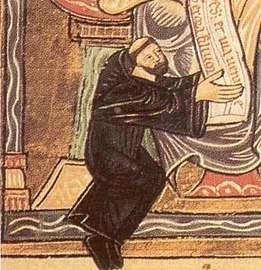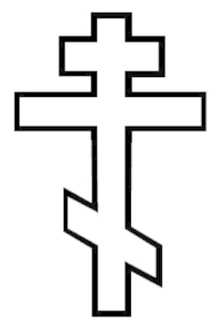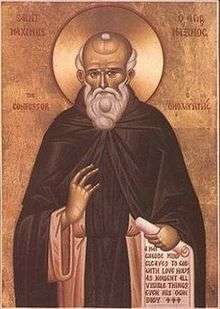November 18 (Eastern Orthodox liturgics)
November 17 - Eastern Orthodox liturgical calendar - November 19
All fixed commemorations below are observed on December 1 by Orthodox Churches on the Old Calendar.[note 1]
For November 18, Orthodox Churches on the Old Calendar commemorate the Saints listed on November 5.
Saints
- Martyr Romanus the Deacon of Caesarea,[1] and child-martyr Barulas of Antioch[2][3] (298 or 303)[4][5][6][7][8][note 2]
- Great-martyr Platon of Ancyra (306)[5][10][6][11][note 3]
- Martyrs Zacchaeus the Deacon and Alphaeus, of Caesarea in Palestine (307)[4][5][6][12][13]
- Venerable Basil.[6][14][note 4]
Pre-Schism Western saints
- Saint Maximus of Mainz, nineteenth Bishop of Mainz in Germany from 354 to 378, who suffered greatly at the hands of the Arians (378)[15][note 5]
- Martyrs Oriculus and Companions, martyrs under the Arian Vandals near Carthage in North Africa (c. 430)[15][note 6]
- Saint Nazarius, a monk and Abbot of Lérins in France (c. 450)[15]
- Saint Mabyn (Mabena), nun of Cornwall (5th century)[5]
- Saint Mawes (Maudetus, Maudez), Bishop in Cornwall and Brittany (5th or 6th century)[4][5][15][note 7]
- Saint Keverne (Akeveranus), a friend of St Kieran or Piran in Cornwall (6th century)[15]
- Saint Mummolus (Mumbolus, Momleolus, Momble), born in Ireland, he was a companion of St Fursey whom he succeeded as Abbot of Lagny in France (c. 690)[15]
- Saints Amandus (708) and Anselm (c. 750), Abbots of Lérins Abbey.[15][note 8]
- Saint Constant, priest-hermit at Lough Erne in Ireland (777)[15]
- Saint Odo of Cluny (942)[4][5][note 9]
Post-Schism Orthodox saints
- Saint Helen, Abbess of Novodevichy Convent, Moscow (1547)[4]
- New Martyr Anastasius of Paramythia in Epirus, by beheading, and martyr Daniel (Musa) (1743 or 1750)[4][5][6][16][note 10]
- Saint Nicholas, priest, confessor (1948)[5][18]
Other commemorations
Icon gallery
 St. Mabyn (Mabena).
St. Mabyn (Mabena). St. Odo of Cluny.
St. Odo of Cluny.
Notes
- The notation Old Style or (OS) is sometimes used to indicate a date in the Julian Calendar (which is used by churches on the "Old Calendar").
The notation New Style or (NS), indicates a date in the Revised Julian calendar (which is used by churches on the "New Calendar"). - "At Antioch, the birthday of St. Romanus, martyr, in the time of the emperor Galerius. When the prefect Asclepiades broke into the churches and strove to destroy them completely, Komanus exhorted the Christians to resist him, and after being subjected to dire torments and the cutting out of his tongue (without which, however, he spoke the praises of God), he was strangled in prison and crowned with a glorious martyrdom. Before him suffered a young boy named Barula, who being asked by him whether it was better to worship one God or several gods, and having answered that we must believe in the one God whom the Christians adore, was scourged and beheaded."[9]
- Name days celebrated today include:
- Platon (Πλάτωνας).
- He is recorded in Parisian Codex 1578, without any other details however.
- "At Mayence, St. Maximus, bishop, who, after suffering much from the Arians, died a confessor, in the time of Constantius."[9]
- "The same day, the Saints Oriculus and his companions, who suffered for the Catholic faith, in the persecution of the Vandals."[9]
- Born in Wales, he lived as a hermit near Falmouth in Cornwall, where a village is named after him. Later he went to Brittany where he is known as St Maudez and where many churches are dedicated to him.
- St Amandus succeeded St Aigulphus as Abbot of Lérins in France in 676. St Anselm, another Abbot of Lérins, lived later in the eighth century.
- "At Tours, the departure from this life of blessed Odo, abbot of Cluny."[9]
- Anastasius and his sister were Greek peasants living in Epirus under Ottoman rule. One day a band of Turks came through their village, led by Musa, the son of the local Pasha (Governor). Musa was struck by the beauty of Anastasius' sister and tried to seize her, but Anastasius threw himself at the Turks and fought them off long enough for his sister to escape. Musa's father had Anastasius arrested and brought before him and, impressed by his courage, attempted to convert him to Islam by many means: threats, beatings, and offers of worldly honor; but Anastasius held firm and was cast into prison. Musa was moved by the way that Anastasius bore all these trials and temptations, and wanted to know more about the Faith that sustained him. Going secretly to Anastasius' prison cell, he peered in and saw two young men of shining appearance with the prisoner. They vanished as soon as Musa entered. Anastasius told Musa that these were angels who guard and aid every Christian, especially when they suffer for Christ. He also explained in a simple way the Gospel of Jesus Christ, which enables His followers to set little value upon worldly things. Musa, deeply moved, threw himself at Anastasius' feet and asked to become a Christian. Anastasius told him to wait until the proper time, because his conversion would cause his father to persecute all the Christians under his power. A few days later, in 1750, Anastasius was beheaded by order of the Pasha. Soon after this, Musa visited the tomb of a holy Martyr and was granted a vision of Anastasius, who appeared to him encircled in light and urged him to continue on the road to Christ. Musa fled his father's domain to the Peleponnese where he received direction in the Faith from an aged ascetic. He then traveled to Venice to be baptized without fear of reprisal by the Turks. In time he became a monk on Corfu, receiving the monastic name of Daniel. He lived there in asceticism, but the desire grew in him to taste martyrdom for Christ, so he traveled to Constantinople to declare his conversion to the Muslims. But the Christians there dissuaded him, knowing that the conversion of such a prominent Turk would, if it were known, lead to retaliation against Christians. Saint Daniel returned to Corfu, where he founded a church in honor of St Anastasius and reposed in peace.[17]
- His relics are located in the Church of the Protaton at Karyes on Mount Athos.
- See: (in Russian) Собор святых земли Эстонской. Википедии. (Russian Wikipedia).
gollark: RFC1149-compliant avian carriers.
gollark: Oh, and your image is stupid too.
gollark: No, Go is very bad, do not use it.
gollark: no.
gollark: AWAKEN THE SHEEPLE
References
- Great Synaxaristes: (in Greek) Ὁ Ἅγιος Ῥωμανός. 18 Νοεμβρίου. ΜΕΓΑΣ ΣΥΝΑΞΑΡΙΣΤΗΣ.
- Great Synaxaristes: (in Greek) Τὸ Ἅγιο Νήπιο. 18 Νοεμβρίου. ΜΕΓΑΣ ΣΥΝΑΞΑΡΙΣΤΗΣ.
- The youth Barulus. OCA - Lives of the Saints.
- November 18 / December 1. Orthodox Calendar (PRAVOSLAVIE.RU).
- December 1 / November 18. Holy Trinity Russian Orthodox Church (A parish of the Patriarchate of Moscow).
- (in Greek) Συναξαριστής. 18 Νοεμβρίου. ECCLESIA.GR. (H ΕΚΚΛΗΣΙΑ ΤΗΣ ΕΛΛΑΔΟΣ).
- Great Synaxaristes: (in Greek) Ὁ Ἅγιος Ῥωμανὸς ὁ Μάρτυρας ἀπὸ τὴν Παλαιστίνη. 18 Νοεμβρίου. ΜΕΓΑΣ ΣΥΝΑΞΑΡΙΣΤΗΣ.
- Martyr Roman the Deacon of Caesarea. OCA - Lives of the Saints.
- The Roman Martyrology. Transl. by the Archbishop of Baltimore. Last Edition, According to the Copy Printed at Rome in 1914. Revised Edition, with the Imprimatur of His Eminence Cardinal Gibbons. Baltimore: John Murphy Company, 1916. p. 355-356.
- Great Synaxaristes: (in Greek) Ὁ Ἅγιος Πλάτωνας. 18 Νοεμβρίου. ΜΕΓΑΣ ΣΥΝΑΞΑΡΙΣΤΗΣ.
- Martyr Platon of Ancyra. OCA - Lives of the Saints.
- Great Synaxaristes: (in Greek) Οἱ Ἅγιοι Ζακχαῖος καὶ Ἀλφαῖος. 18 Νοεμβρίου. ΜΕΓΑΣ ΣΥΝΑΞΑΡΙΣΤΗΣ.
- Martyr Zacchaeus the Deacon of Caesarea in Palestine. OCA - Lives of the Saints.
- Great Synaxaristes: (in Greek) Ὁ Ὅσιος Βασίλειος. 18 Νοεμβρίου. ΜΕΓΑΣ ΣΥΝΑΞΑΡΙΣΤΗΣ.
- November 18. Latin Saints of the Orthodox Patriarchate of Rome.
- Great Synaxaristes: (in Greek) Ὁ Ἅγιος Ἀναστάσιος ὁ Νεομάρτυρας. 18 Νοεμβρίου. ΜΕΓΑΣ ΣΥΝΑΞΑΡΙΣΤΗΣ.
- New Martyrs Anastasius of Epirus and Daniel (1750). Holy Trinity Russian Orthodox Church (A parish of the Patriarchate of Moscow).
- (in Russian) 1 декабря (18 ноября). Православная Энциклопедия под редакцией Патриарха Московского и всея Руси Кирилла (электронная версия). (Orthodox Encyclopedia - Pravenc.ru).
- (in Greek) 18/11/2015. Ορθόδοξος Συναξαριστής.
Sources
- November 18 / December 1. Orthodox Calendar (PRAVOSLAVIE.RU).
- December 1 / November 18. Holy Trinity Russian Orthodox Church (A parish of the Patriarchate of Moscow).
- November 18. OCA - The Lives of the Saints.
- The Autonomous Orthodox Metropolia of Western Europe and the Americas (ROCOR). St. Hilarion Calendar of Saints for the year of our Lord 2004. St. Hilarion Press (Austin, TX). p. 86.
- The Eighteenth Day of the Month of November. Orthodoxy in China.
- November 18. Latin Saints of the Orthodox Patriarchate of Rome.
- The Roman Martyrology. Transl. by the Archbishop of Baltimore. Last Edition, According to the Copy Printed at Rome in 1914. Revised Edition, with the Imprimatur of His Eminence Cardinal Gibbons. Baltimore: John Murphy Company, 1916. p. 355-356.
- Rev. Richard Stanton. A Menology of England and Wales, or, Brief Memorials of the Ancient British and English Saints Arranged According to the Calendar, Together with the Martyrs of the 16th and 17th Centuries. London: Burns & Oates, 1892. pp. 554-557.
Greek Sources
- Great Synaxaristes: (in Greek) 18 ΝΟΕΜΒΡΙΟΥ. ΜΕΓΑΣ ΣΥΝΑΞΑΡΙΣΤΗΣ.
- (in Greek) Συναξαριστής. 18 Νοεμβρίου. ECCLESIA.GR. (H ΕΚΚΛΗΣΙΑ ΤΗΣ ΕΛΛΑΔΟΣ).
- (in Greek) 18/11/2015. Ορθόδοξος Συναξαριστής.
Russian Sources
- (in Russian) 1 декабря (18 ноября). Православная Энциклопедия под редакцией Патриарха Московского и всея Руси Кирилла (электронная версия). (Orthodox Encyclopedia - Pravenc.ru).
- (in Russian) 18 ноября по старому стилю / 1 декабря по новому стилю. Русская Православная Церковь - Православный церковный календарь на 2018 год.
This article is issued from Wikipedia. The text is licensed under Creative Commons - Attribution - Sharealike. Additional terms may apply for the media files.

